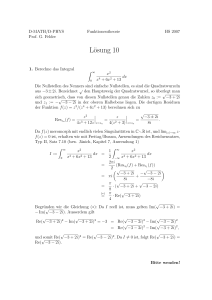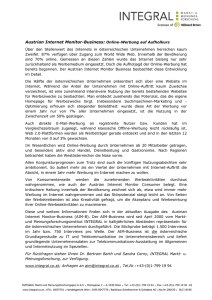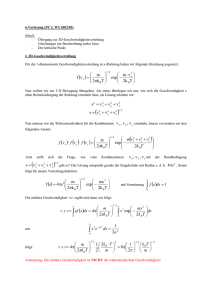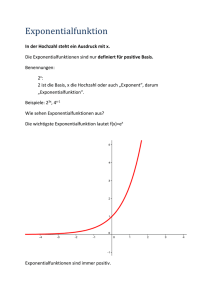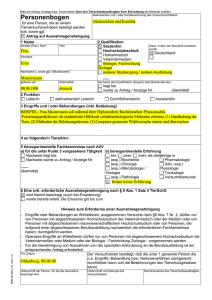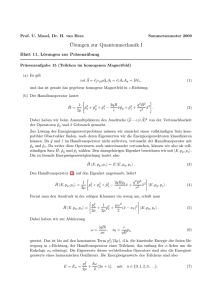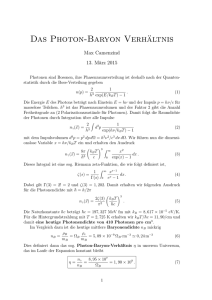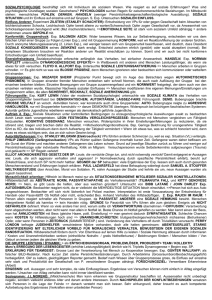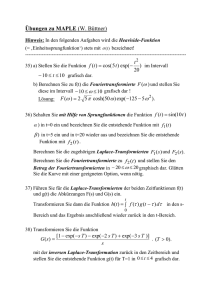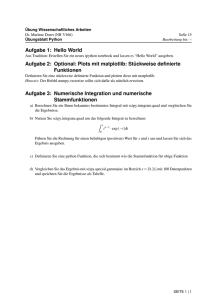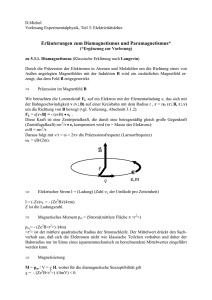A Note on the Overlap Integral of two Harmonic
Werbung
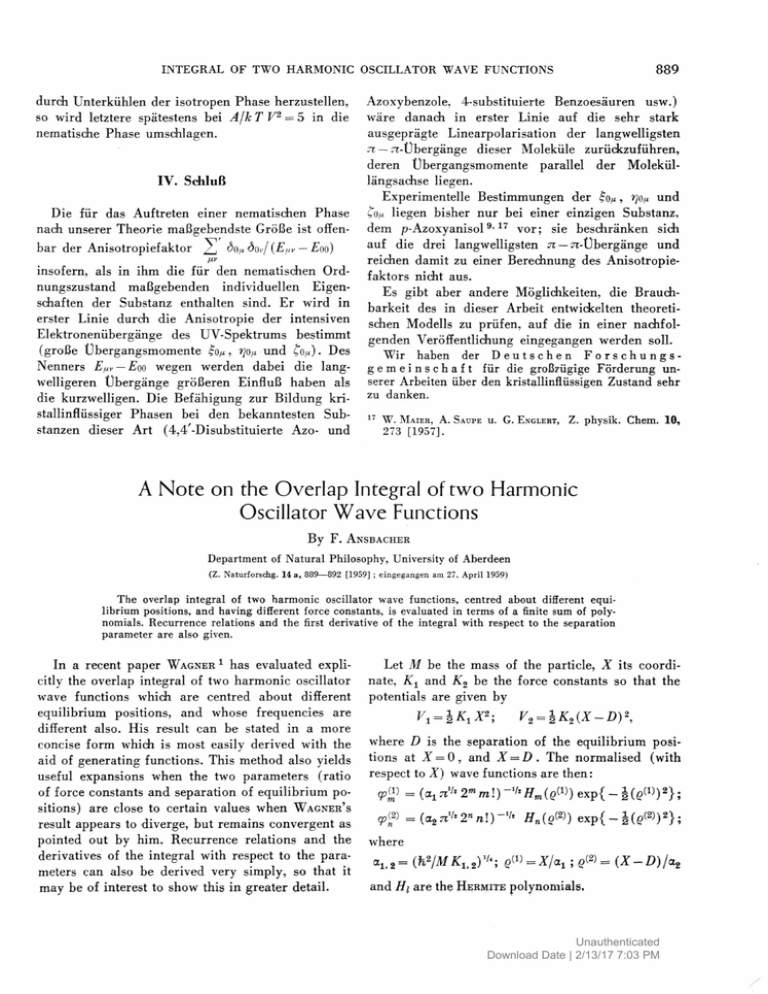
durch Unterkühlen der isotropen Phase herzustellen,
so wird letztere spätestens bei A/hTV2 = 5 in die
nematische Phase umschlagen.
IV. Schluß
Die für das Auftreten einer nematischen Phase
nach unserer Theorie maßgebendste Größe ist offenbar der Anisotropiefaktor
2
do, do v /(Euv-Eoo)
FIV
insofern, als in ihm die für den nematischen Ordnungszustand maßgebenden individuellen Eigenschaften der Substanz enthalten sind. Er wird in
erster Linie durch die Anisotropie der intensiven
Elektronenübergänge des UV-Spektrums bestimmt
(große Übergangsmomente £o/<, rjOa und to«). Des
Nenners E^v — Eoo wegen werden dabei die langwelligeren Übergänge größeren Einfluß haben als
die kurzwelligen. Die Befähigung zur Bildung kristallinflüssiger Phasen bei den bekanntesten Substanzen dieser Art (4,4'-Disubstituierte Azo- und
Azoxybenzole, 4-substituierte Benzoesäuren usw.)
wäre danach in erster Linie auf die sehr stark
ausgeprägte Linearpolarisation der langwelligsten
TI — ^T-Übergänge dieser Moleküle zurückzuführen,
deren Übergangsmomente parallel der Moleküllängsachse liegen.
Experimentelle Bestimmungen der fo^, rjOn und
Cou liegen bisher nur bei einer einzigen Substanz,
dem p-Azoxyanisol 9 ' 1 7 v o r ; sie beschränken sich
auf die drei langwelligsten n — yr-Übergänge und
reichen damit zu einer Berechnung des Anisotropiefaktors nicht aus.
Es gibt aber andere Möglichkeiten, die Brauchbarkeit des in dieser Arbeit entwickelten theoretischen Modells zu prüfen, auf die in einer nachfolgenden Veröffentlichung eingegangen werden soll.
Wir haben der D e u t s c h e n
Forschungsg e m e i n s c h a f t für die großzügige Förderung unserer Arbeiten über den kristallinflüssigen Zustand sehr
zu danken.
17
W . MAIER,
273
A . SAUPE U. G . ENGLERT,
Z.
physik.
Chem.
10,
[1957],
A N o t e on the Overlap Integral of t w o Harmonic
Oscillator W a v e Functions
B y
F.
ANSBACHER
Department of Natural Philosophy, University of Aberdeen
( Z . Naturforschg. 14 a , 8 8 9 — 8 9 2 [1959] ; eingegangen am 27. A p r i l 1959)
The overlap integral of two harmonic oscillator wave functions, centred about different equilibrium positions, and having different force constants, is evaluated in terms of a finite sum of polynomials. Recurrence relations and the first derivative of the integral with respect to the separation
parameter are also given.
In a recent paper W A G N E R 1 has evaluated explicitly the overlap integral of two harmonic oscillator
wave functions which are centred about different
equilibrium positions, and whose frequencies are
different also. His result can be stated in a more
concise form which is most easily derived with the
aid of generating functions. This method also yields
useful expansions when the two parameters (ratio
of force constants and separation of equilibrium positions) are close to certain values when W A G N E R ' S
result appears to diverge, but remains convergent as
pointed out by him. Recurrence relations and the
derivatives of the integral with respect to the parameters can also be derived very simply, so that it
may be of interest to show this in greater detail.
Let M be the mass of the particle, X its coordinate, K1 and K2 be the force constants so that the
potentials are given by
=
i ^Z2;
V2 =
IK2(X-D)2,
where D is the separation of the equilibrium positions at X = 0 , and X = D. The normalised (with
respect to X ) wave functions are then:
exp{ -
cpW = (<*! ril* 2mm\)
<pW
Hn(o&)
i(^)
e x p { - KQ®)2}
2
};
;
where
ai,
2=
Klt
and Hi are the
2)1/4;
HERMITE
Q^=X/ai;Q^=(X-D)/a2
polynomials.
Unauthenticated
Download Date | 2/13/17 7:03 PM
In terms of generating functions, H [ ( y ) is given by
where the path of integration in the complex a plane
encircles the origin. Substituting ( 1 ) into the over-
H i i y ) = l \ { 2 n i ) ~ l j > d i O o ~ l ~ ^ exp ( - a 2 + 2 a ?/),
lap integral, the integration over the X-coordinate
(1)
I(m,n;ß,y)
can be carried out and we obtain:
= ftp2> <pf> d*
= ( m ! n\yh 2 - ^ ß
( l + ß
, U
) ~lh exp
2
.exp[(l
where
\ f + f ß 2 j (2 n i) ~2 j>j> do dr
+ ß2)-i{(l-ß2)(o»--T2)
ß = ajot2 ;
y=
t"«"1
+ 2ß2yo-2ßyr
(2)
+
^ßor}]
D/ax.
ß or
i^ß-z
4
The evaluation of
(2)
in terms of
polynomials is obtained by expanding exp
HERMITE
in
integrand of (2) and integrating the series:
m-\-n
\m,n]
l+ß*)
ffo
.
.
\l-ß2J
l'.(m-l)!
(n-l)l
'Hm_diß2y[l-ß*]-1'*)
where
Kmn = (ml n ! ) v ' 2 ~
ßl'*{\
+
ß2) -'/«
exp
(— j
5 and
f ^ j
Hn_i{-ßyil-ß*]-1'1)
[m, n ] = the smaller of the two
integers m, n .
This expression is equivalent to
WAGNER'S
equ.
(a)
( 4 9 ) ,
but here a single sum only is involved.
the case ß~
1
1— ß2
When ß-+l
( 3 ) apparently diverges. It is then best to expand exp
1+oS
>
o
(o 2 - r 2 ) in the integrand of
( 2 ) and integrate.
Defining the polynomial (a, b integers) :
M(a, b;y)
=
1
+
+
W
^
N
l j + • • - = I F x { - a , b \ -y)
(KUMMER'S
function)
(4)
M can be expressed by a generating function as f o l l o w s :
a! (b - 1 ) ! C~a B~b+1
(2 7i i) ~2 j>j> da dr a " 0 " 1 r ^ "
= a! (6 — 1 ) ! C~aB-b+1[(a
+ b - 1) I ] " 1 (2 n i)
1
exp (A a + B r + C a r)
j> da a " 0 " 1 (B + C a) 0 + 0 - 1 exp Ao
Hence we get for (2)
(1 -ß2) l 2m+n-2 ßn-2(l-r) (-y) n-m-21+4, r
2 ^ 1 ( ^ - 2 r)! (n-m-2
Z+4 r)! ( l + ^ ) n + 2 r - i
inti^/2]Y
I(m,n;ß,y)
-Kmn
^
•Qjf(m-2r
where i n t [ | m ] means greatest integer less than or equal to
rn
< n; if
Here we expand exp
M . WAGNER, Z .
n-m-2/ + 4r+li
Naturforschg.
^* 7
14A, 81
;
(5)
also in this expression it is assumed that
simply interchange m and n .
(b)
1
f
the case /
*h e integrand of ( 2 ) and integrate.
[1959].
Unauthenticated
Download Date | 2/13/17 7:03 PM
W e again define a polynomial b y :
E~r(-D)-r
!
r(r-l)
i(s-r)+l
=
N(
rj
u
(2
710
"2 H
{DIE)2
1!
u
d +
2/
ex
P [ D { o 2 - x 2 ) +Eo
( d + 1 ) ( d + 2
y=—D2/E2;
2!
)
c = r;
r]
[(£>/£)2]2
W
I C ( c - l ) ( c - 2 ) ( c ~ 3 ) y2
-f
1
where
T~s_1
dT
r(r-l) (r-2) (r-3)
[i(s-r)+l][t(s-r)+2]
1
c(c~1)
- 1 +
do
c ( c - l ) . . . ( c - 2 ; + l)
2!
(d + 1) . . . ( d + / )
,
/'!
'
' ' '
^
— r)j 2 .
d={s
It is obvious f r o m the contour integral that ( 6 ) is zero unless r, 5 are both even or both odd integers.
This polynomial does not seem to have been used in the literature. It satisfies the differential equation
y ^ y - l ) ^
+ [ 2 y ( 2 c + 3) —d]
+ c ( c + 1) JV = 0 ;
(8)
with N defined by ( 6 ) or ( 7 ) . ( 8 ) can be transformed into a hypergeometric equation. When c, d are not
integers ( 6 ) still gives a solution of ( 8 ) by making cuts in the complex o and r planes.
Using ( 7 ) we obtain for the overlap integral
/(m, n; ß, y) =Kmn
2
i=o
vl
L-
( - 1)
l+n—m
2
„
m+n+l
(1 + ß2)~2~ßm+ld
, ,
„
n—m—l
- ß2)
l /-. ,
. yi
11-p~ _ „ « _ o" „ , -J I VJ. I/11\
\ ~\rf I
L n
U\s^ H \
- *
,
n — m—l
s=0 ( m - s ) ! — —
! w
V
»
—
2
„
, ,
n — m 7— t
2— ; ' -
Ä
'\_RZ\2
L-p~
T Z+Äß>
« )
\l
x
;
(
9
)
Here § (n — m — I) must be an integer so that with
(m, n)
(m, n)
both even or both odd,
one odd and one even,
The expansion obtained by
in each term of the sum.
WAGNER
I runs through even integers 0, 2, 4, . . .
I runs through odd integers 1, 3, 5, . . .
follows f r o m
(3)
Hl(y)=2-i£Hr(0)
by using a recurrence relation on one
Ht.r(V2
HERMITE
factor
y);
This follows f r o m the addition theorem of H E R M I T E polynomials, which can be obtained from ( 1 ) by
writing: e x p ( — o 2 + 2 o y) = exp ( — | o 2 + 2 o y) exp ( — J o 2 ) , expanding the last term and integrating ( 1 ) .
Finally it may be of interest to quote recurrence relations for the overlap integral. Partial integration
of (2) with respect to o gives:
I(m, n; ß,y)
= ^ ^
j / ^ - y I(m - 1, n; ß, y) +
+ lT/R/
= - Y+ßz j/^Hm,n-l;ß,y)
+ ^ ^
|/~/(m
m
- 1, n - 1 ;
—-f(m-2,n;ß,y)
(10a)
7)
The last result follows from ( 2 ) by partial integration with respect to r .
Differentiation of ( 2 ) with respect to y yields:
d
l
^
^
= I^d-ßynm,n;ß,y)]+V^rnßI(m-l,n;ß,y)
- ]/2n y I(m, n - 1; ß, y).
(11)
Unauthenticated
Download Date | 2/13/17 7:03 PM
The corresponding result for dl/dß is rather complicated and will be omitted.
Most of the above results were obtained several
years ago in the course of an investigation into nonradiative transitions in phosphors (unpublished but
see H A U G 2 ) undertaken at the University of Bristol
under Professor N. F. M O T T , to whom I am very
grateful for suggesting the problem and for many
2
A. HAUG, Halbleiterprobleme I, p. 227, Herausgeber
Schottky, F. Vieweg & Sohn, Braunschweig 1954.
W.
discussions. The author is engaged at present in
finding approximate values for the overlap integral
valid for large m, n and arbitrary ß, y . Should this
be successful, the treatment of lattice-localised electron interactions becomes more promising; the work
involved in using the most useful expansions (3)
[or ( 5 ) ' a n d (9) to a lesser extent] in a problem involving large m or /t, is prohibitive as no comprehensive tables of the appropriate polynomials are
yet available.
Definition und Eigenschaften der bikubisch-sphärischen Harmonischen
V o n
HELMUT
BROSS
Aus dem Institut für theoretische und angewandte Physik der Technischen Hochschule Stuttgart
und Max-Planck-Institut für Metallforschung Stuttgart
(Z. Naturforschg. 14 a, 892—900 [1959] ; eingegangen am 11. Dezember 1958)
Durch Linearkombinationen von Produkten aus Kugelflächenfunktionen der beiden Variablenpaare
cp und
cp' werden neue Funktionen, die sogenannten bikubisch-sphärischen Harmonischen, gebildet, die invariant gegenüber allen Deckoperationen der kubisch-enantiomorph-hemiedrischen bzw. kubisch-holoedrischen Symmetriegruppen sind. Einige Eigenschaften der bikubischsphärischen Harmonischen werden näher untersucht. Für die Berechnung der Koeffizienten der
Entwicklung von bikubisch-sphärischen Harmonischen nach Produkten von Kugelflächenfunktionen
<f>) ' Y c p ' )
werden mehrere Methoden und die numerischen Werte für l+T
12
angegeben.
1. Einführung; Allgemeine Betrachtungen des
Transformationsverhaltens von Produkten
aus Kugelflächenfunktionen
Bei verschiedenen Problemen in der Physik treten
Funktionen auf, die von den Komponenten x, y, z
und x, y', z der beiden Vektoren X und t ' eines
kartesischen Koordinatensystems so abhängig sind,
daß sie invariant gegenüber allen reinen Drehoperationen der kubischen Gruppe sind. Funktionen
mit dieser Eigenschaft nennen wir bikubisch-symmetrisch. In rechtwinkligen Koordinaten sind die
analytischen Ausdrücke für diese Funktionen sehr
unübersichtlich und eignen sich daher kaum für die
mathematische Behandlung bestimmter Aufgaben
(z. B. zur Lösung einer Integralgleichung). Für viele
Fälle hat es sich als günstig erwiesen, an Stelle der
rechtwinkligen Koordinaten x, y, z und x, y', z
sphärische Polarkoordinaten durch
tionen zu entwickeln. Diese Entwicklung ist nach
HOBSON 1
immer möglich, wenn die Funktion F(X, t ' )
bei festgehaltenem X nur solche Unstetigkeiten besitzt, daß das Integral
f F(x,x')
da) r
genommen
über einen kleinen, jedoch beliebigen Bereich der
Oberfläche im r-Raum einen endlichen Wert hat.
Als Funktion von r' soll F ( x , t ' )
dieselbe Eigen-
schaft besitzen. Im folgenden beschränken wir uns
nur auf solche Funktionen, so daß folgende Entwicklung möglich ist *
F(X,X') = J y F » » ' (r, r)
i v
m m'
Ylm($,cp)Ytm'{V,cp').
(2)
Aus den (2 Z + 1 ) ( 2 + 1) Produkten
Ylm{$,cp)
• Yi'm' (&', cp') lassen sich durch Ausreduktion Funktionen bilden, die sich wie Darstellungen
der
reinen Drehungsgruppe transformieren 2
E. W. HOBSON, The Theory of Spherical and Ellipsoidal
Harmonics, Univers. Press, Cambridge 1931, p. 347.
* Yim(&,cp)
sind normierte Kugelflächenfunktionen
(2Z+1)
( Z - m ) ! 1/2
1
r sin $ cos cp ,
X = r sin # sin cp ,
r cos # ,
T
sin
cos cp',
sin $ sin cp',
T
COS FF
T
r' =
(1)
einzuführen und die Funktionen mit bikubischer
Symmetrie nach Produkten von Kugelflächenfunk-
Ylm ($> <p) =
• Pim(cos #) •eimf .
4 7i
(l + m)\
E. WIGNER, Gruppentheorie und ihre Anwendung auf die
Quantenmechanik der Atomspektren, Vieweg, Braunschweig 1931.
Unauthenticated
Download Date | 2/13/17 7:03 PM
